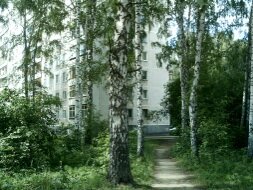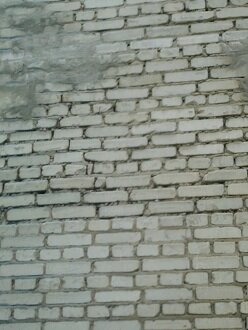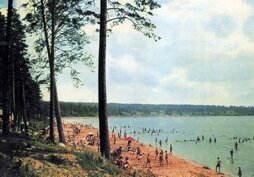Apartment building in Akademgorodok, 2006

One of the major settings of the book is the science town of Akademgorodok,
‘Academy-ville’, founded in 1958 in the woods outside the Siberian city of Novosibirsk. I made a research trip there in 2006, by which time the town had survived a decade and more of post-Soviet neglect. I still found glimpses, though, of its golden age in the 1960s. Not to mention a private ocean. These are extracts from my travel notes.
Siberia
On the flight from Moscow to Novosibirsk, two middle-aged men in the row in front of us are drinking surreptitiously from flasks, getting over-emphatic and using the aisle for their conversation, but maintaining what Simmi (my translator) says is the ideal of Russian drunkenness, always a bit lit up but keeping your balance, breezing on, not wobbling, nowhere near (for example) throwing up. One’s in neat dark clothes, pepper and salt hair, face like an elderly little boy, and that high colour which happens to some Russian men in middle age and looks a bit Irish; the other’s bulkier, more bouffant, with assertive hands and an air of somehow stupid confidence, wearing cream clothes and cream slip-on shoes at the end of unexpectedly spindly legs. Makes me think of the actor who plays Grouty the prison kingpin in Porridge.
Somehow Mr Cream Shoes has managed to annoy a young man from further up the plane, who as we’re just coming in to land comes & stands in his face in the aisle & clearly threatens him; at which Mr Cream unhelpfully laughs. Altercation in aisle; steward separating them; sudden appearance from rear of plane of decisive moustached 20-something bloke - flight marshal? soldier? somebody trained, anyway - who grips the young man’s arms in the air over his head from behind, bends him backwards, and frogmarches him swiftly away. It’s the same posture the Militsiya use when we see them hustling the boy off across the concrete after we land. Throughout, Mr Cream and Mr Naughty Boy continue to throw in provocative remarks, barracked in their turn by a remonstrating old lady one row further forward. I suppose the whole thing is not much different from pissed Englishmen disrupting a flight to Ibiza, only there’s something unfamiliar-feeling in the unrowdy boozing, the matter-of-fact force of the response to the situation, the sense of things being ordinarily a little out of control.
We skirted Novosibirsk on a ring road. Wonderful moment early on, driving in dawn light across flat open land tilted slightly downward to a horizon spiked with metal radio towers rising straight out of the red glow of the rising sun. Then lots of avenues with trams, factories, etc - low density sprawl going on and on, till we crossed the dam over the river Ob. Seagulls on the chainlink fence. And then the industrial scatter continued - massive sluices, more factories, hillsides given to apartments - without stopping, to Akademgorodok, which clearly isn’t a separate oasis now , if it ever was. The trees got denser, that was all. And arriving at the hotel - 8 storeys of raw yellow-grey brick, retrofitted with varnished Russian-ranchero woodwork - I was primarily disappointed. I felt as if I’d hoodwinked myself into enthusiasm over crud.
But the eye adjusts. Went for a 3-hr walk with Simmi, to stay awake in the face of jetlag, and saw a lot more low-grade messy architecture, but also first inklings of how this had been found a beautiful place, a much loved place, more than just an extension of the Novosibirsk sprawl.
Trees have grown back in along the avenues, so the lines of apartment buildings on, e.g., Morskoi Prospekt, don’t declare themselves, don’t form a streetscape the way they did in the 1960s photographs of the new town. These blocks - I think at the top end of apartment quality in the housing caste system, and therefore for scientists who didn’t qualify for the rare cottages - are maroon and yellow now, with balconies that have been pretty much but not universally boxed-in in varnished wood planking to give a kind of overhanging semi-Arabic look; each balcony now a little wooden greenhouse, or storage space stuffed with cardboard boxes. They might glow very cosily in winter. Wide roads, with far more traffic now than in the past: the hurtling, bashed, spectacularly dirty little buses, underlying colour cream, but also a caste system of cars, with Ladas and old Gaz’es at the bottom, and then newer and more Western-looking models of Russian car, then at the top Toyotas and the occasional VW. Not the BMWs Simmi says crowd New-Russian Moscow. Footpaths, back from the roads, often losing their asphalt into potholes or a mosaic of cracked grey; but a resemblance, because of the proportions of the spaces, to a leafy American suburb. Houses/apartments under trees; paths; wide road; mirror image of the same on the other side. A version, strangely, of the same kind of civilisation; a similar outline with different content.
We walked up Ilich St - hotel, shops, cinema, post office - crossed Morskoi to the Dom Uchonykh [House of Scientists] - concrete pillared modernist cultural centre, with bare foyer with wall of unused enamelled notice boards for the French Club, Spanish Club, Philately Club, etc, and clubby ‘restaurant’ clearly intended more for occasions toasting and dancing than for walk-in-off-the-street eating (but was anywhere for that? this is all ‘special distribution channels’, after all) - and galleried 2-storey space with greenery, fish-tanks, internal woodwork, double-height windows, with meeting rooms opening off. Ugly-comfy Soviet sofas. Presumably here was the gallery space that showed the avant-garde paintings (amateur park-railing pretty landscapes now, for sale). An oasis in winter, a Siberian vivarium, with scientific fauna and ferns.
But really started to be delighted when we walked up Zolotaya Dolina St, i.e. into the renamed ‘Golden Valley’ itself, a downward-sloping crease in this forested bluffland above the Ob; and the sun shone in a blue Siberian sky as we entered the privileged zone of the cottages, in their (usually) overgrown gardens. As buildings, they themselves were no better executed. In fact, when you looked closely, they were boxes made of the same concrete panels as the apartment buildings, with the same clumsy cement seams, only with wooden gables and roofs on top, and lean-to conservatories with French doors. But Siberian grasshoppers were whirring underfoot, and a very kindly version of Siberian nature enveloped you: a feathery knee-high or thigh-high mix of ferns and bracken and nettles and flowers down below - some like hollyhocks, some like foxgloves, some like long-stemmed dandelion bushes, some like dogroses, some as blue as cornflowers - and clover, and seeded grasses: a whole ungardened ground-level ecosystem, fresh and green and washed clean by the rain and warmed by the sun and with a mingled warm smell of earthy growth. And above, the other half of the invariable mix of Akademgorodok, trees always tall and slender, silver birches and pines with paper-white or ruddy-barked narrow trunks in dense groves of slender verticals, rising to a canopy of (sometimes) dark-green needles and (mostly) silver-green little leaves in profuse, delicate hanging tresses (think of the way willows hang). It was deeply peaceful walking up Voevodskii back around to the beginning of the line of Institutes on Tereshkova. Under the canopy you don’t have the fen-like sense of the sky’s enormity. It’s a sky of leaves you get, full of dappled light and swishing movement in breezes. Only from my room on the 7th floor of the hotel do I see above the canopy. Here I’m on a level with the treetops, and the sky if 180 degrees of the world again, and I can see than an ocean of trees all roughly equal in height fills this whole wide, wide valley of the Ob; a floor of leaves only broken by the big lumps of industry here and there on the horizon.
This is the Russian wood, or a locally delicate and delightful Siberian version of it, that I saw 19th C painters learning how to see & celebrate in place of pastiches of picturesque Italy, in that very good exhibition of Russian landscape art I saw at the National Gallery in London a couple of years ago. It seems to me that this is also the archetypal Russian wood of fairytales, skazki. You can see this most strongly in the extraordinarily beautiful tract of untouched woodland between Science Prospekt and University Prospekt, where the path along which workers at umpteen Institutes could commute to the ‘living zone’ leads through groves so quiet, so removed from concrete panelling, that it’s hard to believe you’re in any kind of a town. It’s a kilometre or so of perfect beauty, lit slantingly by tender evening light when we walk along it with Professor F on Sunday. Not quite right, I think, to think of the woodland as making up for the roughness and clumsiness of the buildings. Necessary to think of them as forming a compound truth about the place, a compound experience: silver birches and glowing ferns, and the Presidium of the Siberian Division of the Academy of Sciences built from crumbly grey strata of flat little concrete rectangles, ridged for minimal decorative texture, somewhere between mud bricks and breezeblocks; the courses wandering appreciably, if you look at them close up. The path leading to work, and work happening (in the Computer Centre for instance) in bare prison-like corridors, dimly lit by walls of glass bricks at the ends, stone composite underfoot like polished flattened sandwiches of the bilious little chips of marble in graveyards, and phlegm-coloured paint up to head height, and bare wood office doors, and wiring looping along in bundles. Ad hoc ugliness: improvised click-together monumentally-vast humanly-indifferent zero-craft termite-mound architecture. (Watch out, potentially a cheaply biological metaphor for collectivism there, but it isn’t the collectivism I’m trying to catch, it’s the sense of buildings generated without reference to human bodies.) And this, the combination of forest beauty and crap concrete, being the physical embodiment of Akademgorodok’s intellectual freedom. Its freedom by Soviet standards anyway.
Morskoi Prospekt bends down in a convex curve over the bluff so there’s no actual distant prospect to be seen of the toy ocean the Ob dam has made, and there probably wasn’t a view forty years ago either when there were fewer trees. Over the two-lane highway to Berdsk, where a man is slumped over a little plastic table next to the kvass [soft drink made from fermented bread] wagon he’s staffing, and down a winding forest path to a wire-boxed footbridge over a railway which turns out to be the Turk-Sib line of 1930s agitprop fame, and down terraced and railed concrete steps with a bit of annuniciatory seaside pizzazz to them. And out the pines at the foot of the stairs, there’s the beach; sudden sand with stones not shells in it, not surprising since all the sand came here by railroad car from some sandpit somewhere. Plus many bottle-caps. Sign-post offering Police, Administration, Café and Toilets. Beach occupies the innermost bit of the deep bay, bite-shaped, on this side of the Ob Sea. Dam’s out of sight beyond the point to the right, which is good for the illusion, and on the left the low green rim of the bluff stretches a few kilometres away to another point at about ten o’clock as you look out from the beach. With, inevitably, something heavy-industrial on the point sporting one of those very tall tapered chimneys coloured barber’s-shop red and white. (All this industrial metastasis makes me wonder how directly the equation of heavy industry with progress can have affected people’s perceptions, whether it was really possible here in the 1960s to feel a satisfied sense that things were going well, going according to plan, going in the direction of happiness, because the green Siberian horizon was being broken in all quadrants by chimneys, because the pylons were on the march?) But between ten o’clock and say two o’clock, a pretty convincing sea horizon, with the remote far side out of sight, and a couple of sandbank islands where the trees stand like stiff haircuts. Battered white pleasure boats passing, and the odd fishing-boat, and distant dinghy sails. Waves break on the shore leaving a line of shingle ejecta. They’re windblown waves of course, translucent organic green-grey in this greyish Sunday morning light, like a weak algae jelly. Not salty, naturally, and not too cold. This is another of the places, like the top of the hotel, where you get free of trees and see the big Siberian sky. Puffball clouds and grey sheets of down, visibly moving this way. Hardly anybody on the beach yet - a burly round guy sunbathing while his skinny son runs about, and an older woman taking a dip in a red hat. There are red cylindrical buoys about 50 metres out to show the end of the pemissible bathing area. The sun comes out and the water warms to bluey-green glassiness. There are little shelters on legs for changing in. This is beautifully expressive of the ‘Promethean’ strand in Marxism that Kolakowski talks about: Man seizing godlike powers over Nature. Also geared beautifully to Soviet possibilities: we can’t offer any choice in the colour of your swimsuit, and it may not fit too well, but hey, we can run you up the ocean itself, no problem.



Wood, Wall
Science Prospekt
Pocket Ocean Panorama

The Ob Sea in the 1960s